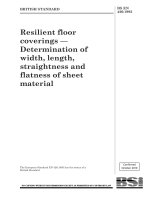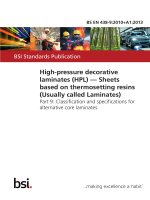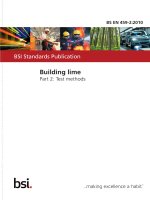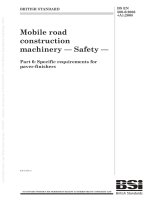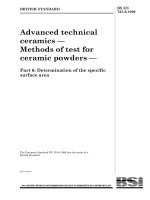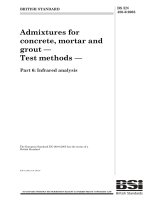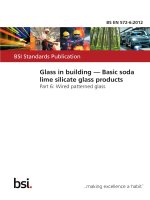Bsi bs en 61850 6 2010
Bạn đang xem bản rút gọn của tài liệu. Xem và tải ngay bản đầy đủ của tài liệu tại đây (2.73 MB, 220 trang )
BS EN 61850-6:2010
BSI Standards Publication
Communication
networks and systems for
power utility automation
Part 6: Configuration description language for
communication in electrical substations related
to IEDs
NO COPYING WITHOUT BSI PERMISSION EXCEPT AS PERMITTED BY COPYRIGHT LAW
raising standards worldwide™
BS EN 61850-6:2010 BRITISH STANDARD
National foreword
This British Standard is the UK implementation of EN 61850-6:2010. It is
identical to IEC 61850-6:2009. It supersedes BS EN 61850-6:2004 which is
withdrawn.
The UK participation in its preparation was entrusted to Technical Committee
PEL/57, Power systems management and associated information exchange.
A list of organizations represented on this committee can be obtained on
request to its secretary.
This publication does not purport to include all the necessary provisions of a
contract. Users are responsible for its correct application.
© BSI 2010
ISBN 978 0 580 56718 6
ICS 33.040.40
Compliance with a British Standard cannot confer immunity from
legal obligations.
This British Standard was published under the authority of the Standards
Policy and Strategy Committee on 31 March 2010.
Amendments issued since publication
Amd. No. Date Text affected
EUROPEAN STANDARD BS EN 61850-6:2010
NORME EUROPÉENNE
EUROPÄISCHE NORM EN 61850-6
ICS 33.200 February 2010 Supersedes EN 61850-6:2004
English version
Communication networks and systems for power utility automation -
Part 6: Configuration description language for communication in
electrical substations related to IEDs
(IEC 61850-6:2009)
Systèmes et réseaux de communication Kommunikationsnetze und -systeme
pour l'automatisation des services für die Automatisierung in der elektrischen
de distribution d'énergie - Energieversorgung -
Partie 6: Langage pour la description Teil 6: Sprache für die Beschreibung
de configuration pour la communication der Konfiguration für die Kommunikation
dans les postes électriques, in Stationen mit intelligenten
entre les dispositifs électroniques elektronischen Geräten (IED)
intelligents (IED) (IEC 61850-6:2009)
(CEI 61850-6:2009)
This European Standard was approved by CENELEC on 2010-02-01. CENELEC members are bound to comply
with the CEN/CENELEC Internal Regulations which stipulate the conditions for giving this European Standard
the status of a national standard without any alteration.
Up-to-date lists and bibliographical references concerning such national standards may be obtained on
application to the Central Secretariat or to any CENELEC member.
This European Standard exists in three official versions (English, French, German). A version in any other
language made by translation under the responsibility of a CENELEC member into its own language and notified
to the Central Secretariat has the same status as the official versions.
CENELEC members are the national electrotechnical committees of Austria, Belgium, Bulgaria, Croatia, Cyprus,
the Czech Republic, Denmark, Estonia, Finland, France, Germany, Greece, Hungary, Iceland, Ireland, Italy,
Latvia, Lithuania, Luxembourg, Malta, the Netherlands, Norway, Poland, Portugal, Romania, Slovakia, Slovenia,
Spain, Sweden, Switzerland and the United Kingdom.
CENELEC
European Committee for Electrotechnical Standardization
Comité Européen de Normalisation Electrotechnique
Europäisches Komitee für Elektrotechnische Normung
Central Secretariat: Avenue Marnix 17, B - 1000 Brussels
© 2010 CENELEC - All rights of exploitation in any form and by any means reserved worldwide for CENELEC members.
Ref. No. EN 61850-6:2010 E
BS EN 61850-6:2010
EN 61850-6:2010 - 2 -
Foreword
The text of document 57/1025/FDIS, future edition 2 of IEC 61850-6, prepared by IEC TC 57, Power
systems management and associated information exchange, was submitted to the IEC-CENELEC
parallel vote and was approved by CENELEC as EN 61850-6 on 2010-02-01.
This European Standard supersedes EN 61850-6:2004.
The main changes with respect to EN 61850-6:2004 are as follows:
– functional extensions added based on changes in other Parts, especially Parts 7-2 and 7-3;
– functional extensions concerning the engineering process, especially for configuration data exchange
between system configuration tools, added;
– provision of clarifications and corrections. Issues that require clarification are published in a database
available at www.tissue.iec61850.com. Arising incompatibilities are listed in 8.2.3.
Attention is drawn to the possibility that some of the elements of this document may be the subject of
patent rights. CEN and CENELEC shall not be held responsible for identifying any or all such patent
rights.
The following dates were fixed:
– latest date by which the EN has to be implemented (dop) 2010-11-01
at national level by publication of an identical
national standard or by endorsement
– latest date by which the national standards conflicting (dow) 2013-02-01
with the EN have to be withdrawn
Annex ZA has been added by CENELEC.
__________
Endorsement notice
The text of the International Standard IEC 61850-6:2009 was approved by CENELEC as a European
Standard without any modification.
In the official version, for Bibliography, the following notes have to be added for the standards indicated:
IEC 61131-3 NOTE Harmonized as EN 61131-3.
IEC 81346-2 NOTE Harmonized as EN 81346-2.
__________
BS EN 61850-6:2010
- 3 - EN 61850-6:2010
Annex ZA
(normative)
Normative references to international publications
with their corresponding European publications
The following referenced documents are indispensable for the application of this document. For dated
references, only the edition cited applies. For undated references, the latest edition of the referenced
document (including any amendments) applies.
NOTE When an international publication has been modified by common modifications, indicated by (mod), the relevant EN/HD
applies.
Publication Year Title EN/HD Year
IEC/TS 61850-2 - -
IEC 61850-5 - Communication networks and systems in - -
IEC 61850-7-1 - substations - -
IEC 61850-7-2 - Part 2: Glossary -
IEC 61850-7-3 - -
IEC 61850-7-4 - Communication networks and systems in EN 61850-5 -
IEC 61850-8-1 - substations - -
Part 5: Communication requirements for
IEC 61850-9-2 - functions and device models -
Communication networks and systems in EN 61850-7-1
substations -
Part 7-1: Basic communication structure for
substation and feeder equipment - Principles
and models
Communication networks and systems in EN 61850-7-2
substations -
Part 7-2: Basic communication structure for
substation and feeder equipment - Abstract
communication service interface (ACSI)
Communication networks and systems in EN 61850-7-3
substations -
Part 7-3: Basic communication structure for
substation and feeder equipment - Common
data classes
Communication networks and systems in EN 61850-7-4
substations -
Part 7-4: Basic communication structure for
substation and feeder equipment - Compatible
logical node classes and data classes
Communication networks and systems in EN 61850-8-1
substations -
Part 8-1: Specific Communication Service
Mapping (SCSM) - Mappings to MMS
(ISO 9506-1 and ISO 9506-2) and
to ISO/IEC 8802-3
Communication networks and systems in EN 61850-9-2
substations -
Part 9-2: Specific Communication Service
Mapping (SCSM) - Sampled values over
ISO/IEC 8802-3
BS EN 61850-6:2010
EN 61850-6:2010 - 4 -
Publication Year Title EN/HD Year
IEC 81346-1 - -
Industrial systems, installations and EN 81346-1
ISO/IEC 8859-1 - equipment and industrial products - -
Structuring principles and reference
RFC 1952 - designations - -
RFC 2045 - Part 1: Basic rules -
- - -
- - Information technology - 8-bit single-byte - -
- - -
coded graphic character sets -
Part 1: Latin alphabet No.1
GZIP file format specification version 4.3 -
Multipurpose Internet Mail Extensions (MIME) -
Part 1: Format of Internet Message Bodies
Extensible Markup Language (XML) 1.0 -
XML Schema Part 1: Structures -
XML Schema Part 2: Datatypes -
– 2 – BS EN 61850-6:2010
61850-6 © IEC:2009(E)
CONTENTS
INTRODUCTION .....................................................................................................................7
1 Scope ...............................................................................................................................8
2 Normative references........................................................................................................8
3 Terms and definitions .......................................................................................................9
4 Abbreviations..................................................................................................................10
5 Intended engineering process with SCL........................................................................... 11
5.1 General .................................................................................................................11
5.2 Scope of SCL ........................................................................................................11
5.3 Use of SCL in the Engineering process ..................................................................12
5.4 IED modifications ..................................................................................................15
5.5 Data exchange between projects ...........................................................................16
6 The SCL object model ....................................................................................................18
6.1 General .................................................................................................................18
6.2 The substation model ............................................................................................22
6.3 The product (IED) model........................................................................................23
6.4 The communication system model ......................................................................... 24
6.5 Modelling of redundancy ........................................................................................25
6.6 Data flow modelling ...............................................................................................25
7 SCL description file types................................................................................................ 26
8 SCL language .................................................................................................................28
8.1 Specification method .............................................................................................28
8.2 Language versions and compatibility......................................................................30
8.3 SCL language extensions ......................................................................................33
8.4 General structure...................................................................................................36
8.5 Object and signal designation ................................................................................37
9 The SCL syntax elements ............................................................................................... 41
9.1 Header ..................................................................................................................41
9.2 Substation description ...........................................................................................43
9.3 IED description ......................................................................................................56
9.4 Communication system description ........................................................................ 87
9.5 Data type templates ............................................................................................... 94
10 Tool and project engineering rights ............................................................................... 106
10.1 IED configurator .................................................................................................. 106
10.2 System configurator ............................................................................................. 107
10.3 Right transfer between projects............................................................................ 107
Annex A (normative) SCL syntax: XML schema definition ................................................... 109
Annex B (informative) SCL enumerations according to IEC 61850-7-3 and IEC 61850-7-4 .. 147
Annex C (informative) Syntax extension examples .............................................................. 153
Annex D (informative) Example .......................................................................................... 166
Annex E (informative) SCL syntax: General XML schema definition .................................... 180
Annex F (informative) XML schema definition of SCL variants ........................................... 204
Annex G (normative) SCL Implementation Conformance Statement (SICS)........................ 210
Bibliography ........................................................................................................................ 215
BS EN 61850-6:2010 – 3 –
61850-6 © IEC:2009(E)
Figure 1 – Reference model for information flow in the configuration process......................... 13
Figure 2 – IED type description to System Configurator ......................................................... 14
Figure 3 – IED instance description to System Configurator ................................................... 15
Figure 4 – Modification process .............................................................................................16
Figure 5 – Engineering right handling in projects....................................................................18
Figure 6 – SCL object model .................................................................................................20
Figure 7 – SA System Configuration example ........................................................................ 22
Figure 8 – ICD files describing implementable IED types of a general IED class..................... 28
Figure 9 – UML diagram overview of SCL schema .................................................................30
Figure 10 – Elements of the signal identification as defined in IEC 61850-7-2 ........................38
Figure 11 – Elements of the signal name using product naming .............................................38
Figure 12 – Possible elements of the signal name using functional naming ............................39
Figure 13 – Names within different structures of the object model.......................................... 40
Figure 14 – UML diagram of Header section ..........................................................................41
Figure 15 – UML diagram of Substation section .....................................................................44
Figure 16 – UML diagram for equipment type inheritance and relations .................................. 48
Figure 17 – Substation section example ................................................................................55
Figure 18 – IED structure and access points..........................................................................57
Figure 19 – UML description of IED-related schema part – Base............................................ 58
Figure 20 – UML description of IED-related schema part for Control blocks ........................... 59
Figure 21 – UML description of IED-related schema part – LN definition ................................60
Figure 22 – UML diagram overview of the Communication section .........................................88
Figure 23 – UML overview of DataTypeTemplate section ....................................................... 95
Figure C.1 – Coordinate example ........................................................................................ 153
Figure C.2 – Schema overview ............................................................................................ 156
Figure D.1 – T1-1 Substation configuration.......................................................................... 166
Figure D.2 – T1-1 Communication configuration .................................................................. 167
Figure D.3 – T1-1 Transformer bay...................................................................................... 168
Table 1 – The files composing the XML schema definition for SCL.........................................29
Table 2 – Attributes of the Private element ............................................................................35
Table 3 – Attributes of the Header element............................................................................42
Table 4 – Attributes of the History item (Hitem) element ........................................................43
Table 5 – Primary apparatus device type codes ..................................................................... 50
Table 6 – Attributes of the Terminal element..........................................................................51
Table 7 – Attributes of the SubEquipment element.................................................................52
Table 8 – Attributes of the LNode element .............................................................................53
Table 9 – General Equipment codes from IEC 61850-7-4.......................................................54
Table 10 – Attributes of the IED element ...............................................................................61
Table 11 – List of service capabilities and setting elements and attributes ............................. 63
Table 12 – Attributes of the Access point element..................................................................66
Table 13 – Attributes of the IED server element .....................................................................68
Table 14 – Attributes of the Authentication element ...............................................................69
– 4 – BS EN 61850-6:2010
61850-6 © IEC:2009(E)
Table 15 – Attributes of the LDevice element.........................................................................69
Table 16 – Attributes of the LN0 element ...............................................................................70
Table 17 – Attributes of the LN element.................................................................................71
Table 18 – Attributes of the DOI element ...............................................................................72
Table 19 – Attributes of the DAI element ...............................................................................73
Table 20 – Attributes of the SDI element ...............................................................................73
Table 21 – Attributes of the DataSet element.........................................................................74
Table 22 – Attributes of the FCDA element ............................................................................75
Table 23 – Attributes of the report control block element........................................................76
Table 24 – Attributes of the RptEnabled element ...................................................................77
Table 25 – Attributes of the ClientLN element ........................................................................78
Table 26 – Attributes of the log control block element ............................................................80
Table 27 – Attributes of the GSE control block element..........................................................81
Table 28 – Attributes of the IEDName element ......................................................................81
Table 29 – Attributes of the sampled value control block element...........................................83
Table 30 – Attributes of the Smv Options element .................................................................83
Table 31 – Deprecated Smv options ......................................................................................84
Table 32 – Attributes of the setting control block element ......................................................84
Table 33 – Attributes of the Input/ExtRef element ..................................................................86
Table 34 – Attributes of the association element ....................................................................87
Table 35 – Attributes of the Subnetwork element ................................................................... 89
Table 36 – Attributes of the ConnectedAP element ................................................................90
Table 37 – Attributes of the GSE element ..............................................................................91
Table 38 – Attributes of the SMV element..............................................................................92
Table 39 – PhysConn P-Type definitions ............................................................................... 93
Table 40 – Template definition elements ...............................................................................97
Table 41 – Attributes of the LNodeType element.................................................................... 97
Table 42 – Attributes of the DO element ................................................................................98
Table 43 – Attributes of the DOType element......................................................................... 98
Table 44 – Attributes of the SDO element..............................................................................99
Table 45 – Data type mapping ............................................................................................... 99
Table 46 – Attribute value kind (Valkind) meaning ............................................................... 100
Table 47 – Attributes of the DA element .............................................................................. 101
Table 48 – Attributes of the BDA element ............................................................................ 104
Table 49 – Attributes of the EnumType element................................................................... 105
Table G.1 – IED configurator conformance statement .......................................................... 210
Table G.2 – System configurator conformance statement .................................................... 212
BS EN 61850-6:2010 – 7 –
61850-6 © IEC:2009(E)
INTRODUCTION
This part of IEC 61850 specifies a description language for the configuration of electrical
substation IEDs. This language is called System Configuration description Language (SCL). It
is used to describe IED configurations and communication systems according to IEC 61850-5
and IEC 61850-7-x. It allows the formal description of the relations between the utility
automation system and the process (substation, switch yard). At the application level, the
switch yard topology itself and the relation of the switch yard structure to the SAS functions
(logical nodes) configured on the IEDs can be described.
NOTE The process description, which is in this standard restricted to switch yards and general process functions,
will be enhanced by appropriate add-ons for wind mills, hydro plants and distributed energy resources (DER).
SCL allows the description of an IED configuration to be passed to a communication and
application system engineering tool, and to pass back the whole system configuration
description to the IED configuration tool in a compatible way. Its main purpose is to allow the
interoperable exchange of communication system configuration data between an IED
configuration tool and a system configuration tool from different manufacturers.
IEC 61850-8-1 and IEC 61850-9-2, which concern the mapping of IEC 61850-7-x to specific
communication stacks, may extend these definitions according to their need with additional
parts, or simply by restrictions on the way the values of objects have to be used.
– 8 – BS EN 61850-6:2010
61850-6 © IEC:2009(E)
COMMUNICATION NETWORKS AND SYSTEMS
FOR POWER UTILITY AUTOMATION –
Part 6: Configuration description language for communication
in electrical substations related to IEDs
1 Scope
This part of IEC 61850 specifies a file format for describing communication-related IED
(Intelligent Electronic Device) configurations and IED parameters, communication system
configurations, switch yard (function) structures, and the relations between them. The main
purpose of this format is to exchange IED capability descriptions, and SA system descriptions
between IED engineering tools and the system engineering tool(s) of different manufacturers in
a compatible way.
The defined language is called System Configuration description Language (SCL). The IED and
communication system model in SCL is according to IEC 61850-5 and IEC 61850-7-x. SCSM
specific extensions or usage rules may be required in the appropriate parts.
The configuration language is based on the Extensible Markup Language (XML) version 1.0
(see XML references in Clause 2).
This standard does not specify individual implementations or products using the language, nor
does it constrain the implementation of entities and interfaces within a computer system. This
part of the standard does not specify the download format of configuration data to an IED,
although it could be used for part of the configuration data.
2 Normative references
The following referenced documents are indispensable for the application of this document. For
dated references, only the edition cited applies. For undated references, the latest edition of
the referenced document (including any amendments) applies.
IEC 61850-2, Communication networks and systems in substations – Part 2: Glossary
IEC 61850-5, Communication networks and systems in substations – Part 5: Communication
requirements for functions and device models
IEC 61850-7-1, Communication networks and systems in substations – Part 7-1: Basic
communication structure for substation and feeder equipment – Principles and models
IEC 61850-7-2, Communication networks and systems in substations – Part 7-2: Basic
communication structure for substation and feeder equipment – Abstract communication
service interface (ACSI)
IEC 61850-7-3, Communication networks and systems in substations – Part 7-3: Basic
communication structure for substation and feeder equipment – Common data classes
IEC 61850-7-4, Communication networks and systems in substations – Part 7-4: Basic
communication structure for substation and feeder equipment – Compatible logical node
classes and data classes
IEC 61850-8-1, Communication networks and systems in substations – Part 8-1: Specific
Communication Service Mapping (SCSM) – Mappings to MMS (ISO 9506-1 and ISO 9506-2)
and to ISO/IEC 8802-3
BS EN 61850-6:2010 – 9 –
61850-6 © IEC:2009(E)
IEC 61850-9-2, Communication networks and systems in substations – Part 9-2: Specific
Communication Service Mapping (SCSM) – Sampled values over ISO/IEC 8802-3
IEC 81346-1, Industrial systems, installations and equipment and industrial products –
Structuring principles and reference designations – Part 1: Basic rules
ISO/IEC 8859-1, Information technology – 8-bit single-byte coded graphic character sets –
Part 1: Latin alphabet No. 1
RFC 1952, GZIP file format specification version 4.3, RFC, available at
< />
RFC 2045, Multipurpose Internet Mail Extensions (MIME) Part One: Format of Internet
Message Bodies, RFC, available at < />
Extensible Markup Language (XML) 1.0, W3C, available at < />xml-20001006>
XML Schema Part 1: Structures, W3C, available at <3 />xmlschema-1-20010502>
XML Schema Part 2: Datatypes, W3C, available at
3 Terms and definitions
For the purposes of this document, the terms and definitions given in IEC 61850-2 apply.
Additionally the following terms are used in the context of language name spaces. Only general
meanings are given here. More details about the handling in the context of SCL can be found
later in this standard.
3.1
extensible
a language is extensible if instances of the language can include terms from other vocabularies
NOTE This is fulfilled in SCL if the other vocabularies come with their own XML name space.
3.2
language
an identifiable set of vocabulary terms that has defined constraints
NOTE This is the case with SCL, although some constraints are not definable in the XML schema.
3.3
instance
a realization by usage of a language
NOTE For example, an XML document in SCL describing an IED or a substation is an SCL instance.
3.4
sender
a tool that creates or produces an instance for processing by another application (receiver)
NOTE SCL senders are typically IED and system configuration tools; e.g. the IED tool sends (produces) ICD files,
the system tool sends SCD files.
3.5
Receiver
a tool that consumes an instance which it obtained from a sender
– 10 – BS EN 61850-6:2010
61850-6 © IEC:2009(E)
NOTE SCL receivers are IED tools and system configuration tools; e.g. the IED tool receives SCD files, the
system tool ICD, IID, SSD and SED files.
3.6
processor
a component which receives SCL instances and produces new instances, i.e. is sender and
receiver
NOTE This is typically the system configuration tool.
3.7
project
a system part with engineering responsibility for all contained IEDs
NOTE Mostly a system is a project. However, sometimes the IED engineering responsibility of different parts of a
system belong to different parties or people. Each IED responsibility area is then a separate project. An IED can
belong only to one project. It is ‘owned’ by this project.
3.8
backwards compatible
a language change is backwards compatible, if newer receivers can process all instances of
the old language
NOTE For SCL this means that tools built for newer language versions can understand instances from older
versions. Especially system tools should understand old ICD and SSD files, while IED tools should understand old
SCD files to be backward compatible.
3.9
forward compatible
a language change is forward compatible if older receivers can process all instances of the
newer language
NOTE For SCL this means that tools built according to older SCL versions can also process instances of newer
SCL versions. Especially old system tools should handle new ICD and SSD files, while old IED tools should handle
new SCD files to be forward compatible.
3.10
language version
the version of the XML schema defining the language
NOTE A language instance is produced according to a language (schema) version, which is called its assigned
version, although it may also be valid against other language versions.
4 Abbreviations
In general, the glossary and abbreviations defined in IEC 61850-2 apply. The following
abbreviations are either exclusive to this standard, or particularly useful for understanding this
standard and are repeated here for convenience.
BDA Basic DATA Attribute ( i.e. not structured)
CIM Common Information Model for energy management applications
DAI Instantiated Data Attribute
DO DATA in IEC 61850-7-2, data object type or instance, depending on the context
DOI Instantiated Data Object (DATA)
ID Identifier
IED Intelligent Electronic Device
ldInst Instance identification of a Logical Device as part of its name
lnInst Instance number of a Logical Node as part of its name
MSV Multicast Sampled Value
BS EN 61850-6:2010 – 11 –
61850-6 © IEC:2009(E)
MsvID ID for MSV (Multicast Sampled Value)
RCB Report Control Block
SCL System Configuration description Language
SDI Instantiated Sub-DATA; middle name part of a structured DATA name
SDO Sub-DATA within a DOType, referencing another DOType
SED System Exchange Description
UML Unified Modelling Language according to />URI Universal Resource Identifier
UsvID ID for USV (Unicast Sampled Value)
XML Extensible Markup Language
5 Intended engineering process with SCL
5.1 General
Engineering of a substation automation system may start either with the allocation of
functionally pre-configured devices to switch yard parts, products or functions, or with the
design of the process functionality, where functions are allocated to physical devices later,
based on functional capabilities of devices and their configuration capabilities. Often a mixed
approach is preferred: a typical process part such as a line bay is pre-engineered, and then the
result is used within the process functionality as often as needed. For SCL, this means that it
must be capable of describing:
a) a system specification in terms of the single line diagram, and allocation of logical nodes
(LN) to parts and equipment of the single line to indicate the needed functionality;
b) pre-configured IEDs with a fixed number of logical nodes (LNs), but with no binding to a
specific process – may only be related to a very general process function part;
c) pre-configured IEDs with a pre-configured semantic for a process part of a certain
structure, for example a double busbar GIS line feeder, or for a part of an already
configured process or automation system;
d) complete process configuration with all IEDs bound to individual process functions and
primary equipment, enhanced by the access point connections and possible access paths in
subnetworks for all possible clients;
e) as item 136Hd) above, but additionally with all predefined associations and client server
connections between logical nodes on data level. This is needed if an IED is not capable of
dynamically building associations or reporting connections (either on the client or on the
server side).
Case 137He) is the complete case. Both cases 138Hd) and 139He) are the result after SAS engineering, while
case 140Ha) is a functional specification input to SAS engineering, and 14Hb) and 142Hc) are possible
results after IED pre-engineering either for a typical usage of the IED, or for a specific usage
within a project.
5.2 Scope of SCL
The scope of SCL as defined in this standard is clearly focussed on these purposes:
1) SAS functional specification (point 5.1 143Ha) above),
2) IED capability description (points 5.1 14Hb) and 5.1 145Hc) above), and
3) SA system description (points 5.1 146Hd) and 5.1 147He) above).
These purposes shall provide standardized support to system design, communication
engineering and to the description of readily engineered system communication for device
engineering tools.
– 12 – BS EN 61850-6:2010
61850-6 © IEC:2009(E)
For practical purposes, the following is also supported:
4) exchange of system interfacing information between two projects handling two systems,
which need to exchange data;
5) exchange of IED modifications on an IED instance engineered specifically for a project
back from the IED tool to the system tool.
This is reached by defining an object model describing the IEDs, their communication
connections, and their allocation to the switch yard, as well as a standardized way to describe
how this model shall be represented in a file to be exchanged between engineering tools. The
resulting object model could also be the base for other engineering tasks, possibly with some
additions. Therefore, and because of the additional needs of SCSMs, this standard considers
the language as defined here as the core model, and defines how extensions of this core
model for SCSMs as well as other (engineering) purposes can be carried out in a standardized
and compatible way.
5.3 Use of SCL in the Engineering process
Figure 1 explains the usage of SCL data exchange in the above-mentioned engineering
process. The text boxes above the dashed line indicate where SCL files are used. The text box
IED capabilities corresponds to a result of steps 5.1 148Hb) and 5.1 149Hc) above, the text box System
specification corresponds to step 5.1 a) above, the text box Associations… refers to steps
5.1 150Hd) or 5.1 15He) above.
To make the engineering tasks and responsibilities clear, tool roles are introduced for an IED
configurator and a system configurator. A ‘real’ tool can play both roles. In this case the
transfer of partly engineered data within the tool is private, but to any other (mostly to an IED
tool) it has to be seen from the role the tool has played when modifying the project data, i.e if
the modification was done in the scope of an IED tool, or in the scope of a system tool.
The IED Configurator is a manufacturer-specific, may be even IED specific, tool that shall be
able to import or export the files defined by this part of IEC 61850. The tool then provides IED-
specific settings and generates IED-specific configuration files, or it loads the IED configuration
into the IED.
An IED shall only be considered compatible in the sense of the IEC 61850 series, if:
• it is accompanied either by an (ICD) SCL file describing its capabilities, or by an (IID) SCL
file describing its project specific configuration and capabilities, or by a tool, which can
generate one or both, of these file types from or for the IED (not shown in Figure 1);
• it can directly use a system SCL (SCD) file to set its communication configuration, as far as
setting is possible in this IED (i.e. as a minimum, its needed communication addresses), or
it is accompanied by a tool which can import a system SCL file to set these parameters to
the IED.
The System Configurator is an IED independent system level tool that shall be able to import
or export configuration files defined by this part of IEC 61850. It shall be able to import
configuration files from several IEDs, as needed for system level engineering, and used by the
configuration engineer to add system information shared by different IEDs. Then the system
configurator shall generate a substation-related configuration file as defined by this part of
IEC 61850, which is fed back to the IED Configurator for system-related IED configuration. The
System Configurator should also be able to read a System specification file for example as a
base for starting system engineering, or to compare it with an engineered system for the same
substation.
BS EN 61850-6:2010 – 13 –
61850-6 © IEC:2009(E)
IED Capabilities System specification
.SSD (Single line, LNs,…)
IED (LN, DO, … ) System .SED System
Configurator
DB System Exchange Configurator
.ICD
Associations, .SCD .IID Instantiated IED .SCD
relation to single line,
Other IEC 61850 project
preconfigured reports, ... with interfaces between
projects
IED
Engineering Engineering Configurator
environment Workplace
File transfer
.CID remote File transfer and
File transfer Parametrization with
Substation IEC 61850 services
SA system Local gateway
IED IED IED
Figure 1 – Reference model for information flow in the configuration process
The part of Figure 1 below the dashed line indicates the ways in which IED configuration data
produced by means of the IED configurator can be brought into the IED. This can be effected
by:
• local communication from an engineering workstation connected locally to the IED. This
data transfer is beyond the scope of this standard.
• remote file transfer, for example by the file transfer method of IEC 61850-7-2. The file
format is not defined within this standard, but SCL format is a possible choice at least of a
part of the configuration data.
• access services to parameter and configuration data defined according to IEC 61850-7-2.
In this case, the standardized methods according to IEC 61850-7-x shall be used.
NOTE It is not in the scope of this standard to define any details of concrete software tools, which support an
engineer in doing the intended engineering process with SCL as described above. Both the system configurator as
well as the IED configurator introduced above are conceptual tools, respectively tool roles to illustrate the use of
different SCL file variants in the engineering process. Each manufacturer is completely free to find the best way to
support engineers by a specific software tool. In addition, complete freedom of choice is given in the way in which
software tools for the above described engineering process with SCL will store manufacturer-specific internal
parameters for IEDs and SA system aspects not covered by the scope of IEC 61850 (e.g. the relation of logical data
to pins on a physical board), and how they relate them to the IEC 61850 data model.
The data exchange between engineering tools during the engineering process can then be as
follows (see Figure 2):
– 14 – BS EN 61850-6:2010
61850-6 © IEC:2009(E)
Figure 2 – IED type description to System Configurator
At start of system engineering the IED capability (ICD) files are used by the system
configurator as IED template (type) description to instantiate project specific IEDs as needed.
As F152H igure 2 shows, this ICD file can be generated in advance as typical configuration of an IED
by means of the IED configurator tool, as typically done for very flexibly configurable IEDs.
Alternatively the system configurator can also import the description of an IED specifically
preconfigured with name and addresses for a concrete function in the process by importing an
Instantiated IED Description (IID) file, as indicated in F153H igure 3.
The SCD file generated by the system configurator tool is then imported by the IED
configurator for the final IED instance configuration, as shown in F154H igure 2 and F15H igure 3. Any
add-ons or adapted values could then be exported by means of the IID file, and thus brought
back to the system configurator respective the next revision of the SCD file – see next
subclause on IED modifications.
BS EN 61850-6:2010 – 15 –
61850-6 © IEC:2009(E)
Figure 3 – IED instance description to System Configurator
5.4 IED modifications
During the engineering process it may happen that the IED-related data has to be changed.
This can in principle be done by removing the IED from the system, and reinstantiating a
modified IED description file in the system. However, in this case also all existing references
from or to the IED are lost and have to be re-established. On the other hand, tool
responsibilities shall be clarified as follows:
The IED configurator is responsible for the IEDs data model, and all its configuration values. It
is not allowed to change any data flow- and communication-related definitions. To assure this,
it shall not directly modify a system description (SCD) file.
The System configurator is responsible for the communication addressing and the data flow
between the IEDs, within the scope of the IED capabilities. It might set configuration and
parameter values as needed from the system point of view. It is not allowed to change the IEDs
data model.
Therefore another SCL file is defined, allowing to update the IED data within a system. It is
called IID file (Instantiated IED Description), and describes the project specific configuration of
an IED. In the case that this IED does not exist in the SCD file, it can be imported completely
and instantiated as a project specific IED, without any references to other IEDs (see also
F156H igure 3). In the case that it exists already, the data model part inclusive any values can
replace the appropriate parts existing in the system configurator. All data flow-related
definitions and references to other IEDs, which exist in the system configurator, are still valid,
because the IED configurator is not allowed to make changes which modify the already
configured data flow. Especially, no names shall be changed, and no referenced parts of the
data model shall be deleted. The general process is shown in F157H igure 4.
– 16 – BS EN 61850-6:2010
61850-6 © IEC:2009(E)
(Class) IED1 IED2 IED2
TEMPLATE
.scd .cid
preconfigure .icd
Proprietary files
1 instantiate reimport / update 2
IED configurator IED configurator
System 3
configurator
IED2
.iid
Figure 4 – Modification process
At the start of system engineering the IED capability (ICD) files are used by the system
configurator to instantiate project specific IEDs as needed (1). The resulting SCD file is then
imported by the IED configurator for the final IED configuration (2). Any add-ons or adapted
values could then be exported by means of the IID file, and thus brought back to the system
configurator respective the next revision of the SCD file (3).
To allow detection of a modified file, the IED owner within the IID file should be set to the
header identification of the SCD file, which was the input to IED engineering before.
5.5 Data exchange between projects
As far as the engineering responsibility is concerned, a complete secondary system can be
split into different parts. Examples include separate engineering of high-voltage level and
medium-voltage level, of a transformer-related part, or even of different substations
exchanging data e.g. for line protection or interlocking. For the purposes of this standard, such
a system part with responsibility for all its contained IEDs is called a project. To allow the
engineering of online communication data flow between such projects, some interfacing data
has to be exchanged between the projects, and the engineered interfaces have to be
reimported to the concerned projects.
NOTE 1 From a statical point of view a project can be considered as a responsibility area. As the exchange of
information between responsibility areas is carried out in processes, the term project is used here.
To facilitate this engineering data exchange, the following rules are set up.
a) An IED always belongs to a project. Only people and tools belonging to the project are
allowed to configure the IED, especially handling of data transfer between the project data
base of the system tool and the IED tool. The owner project has full engineering rights on
the IED.
b) A project can transfer to another project the right to add definitions for data flow from some
of its IEDs (IED check out). This has to be accompanied by a description of those parts of
BS EN 61850-6:2010 – 17 –
61850-6 © IEC:2009(E)
the IED which are allowed to be used and enhanced by the other project. This transfer of
‘data flow’ engineering rights blocks any modification of the exported IED in the owner
project. Before this IED can be modified within the owner project, the ‘data flow’
engineering right has to be transferred back to it (IED check in), normally with some added
data flow definitions.
c) To not lose already engineered references on such exported IED parts, parts of referenced
IEDs have also to be exported as fix IEDs. These are not allowed to be changed by the
importing project, and must be reexported unchanged when the ready engineered IED is
transferred back to the owner project.
d) Needed parts of the Substation section and communication section shall be exported. From
the Substation section only full bays shall be exported, although they shall contain only LN
links to exported IEDs. The importing project is only allowed to add logical node links to the
substation, or add a part of its own substation section. Furthermore, it is allowed to add
addresses in the exiting subnetworks and own subnetworks to the communication section.
It is up to the project engineer to ensure that objects entered by him also have unique
names in the exporting project, and that the entered addresses are unique within the full
Subnetwork.
The transfer of rights occurs by means of an SCL file, called a SED (System Exchange
Description) file. This file also contains the transferred engineering rights (fix, or dataflow) and
the IED engineering capabilities (e.g. number of data sets and control blocks allowed to be
used by the receiving project).
The parts of an IED exported with dataflow rights shall be frozen for engineering at the IED
owner project (after IED check-out), until the using project transfers it back by means of
another SED file (IED check-in). The file transferred back shall have the same SCL Header
identification as the originally exported file but with an increased revision index.
The Header identification of an SCD file is taken as project identification, and therefore it is
always different to that of a SED, which identifies an engineering data transfer between exactly
two projects. The SCD Header identification is used within a SED file to identify the owner
project of an IED.
The transfer and handling of the dataflow and fix rights is defined in the state diagrams of
F158H igure 5 for the project owning the IEDs as well as for the receiving project. Observe that the
full engineering right always stays in the owner project.
